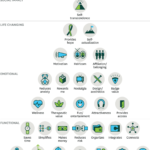https://hbr.org/2016/09/the-elements-of-value
Driving
value definition in today’s digital business. This article from HBR
struck me. It’s been on my desk for two weeks. There’s truly something
here. I’ve pasted a summary of my thoughts this morning, in business
today there is something intrinsic to the value created by digital
experience; however, in financial calculations, project definition and
management and prioritization of development we have a hard time
calculating the benefit of digital customer experience.
I
would define digital customer experience as one of the most important
things a company can do to persist in this day and age. Digital,
website or app, is the first touch most customers have with a company
and will be a lasting impression on the customer for years to come. I’m
interested to see how value definition and value evaluation evolve in
the coming years. Will track closely.
When customers evaluate a product or service, they weigh its
perceived value against the asking price. Marketers have generally focused much
of their time and energy on managing the price side of that equation, since
raising prices can immediately boost profits. But that’s the easy part: Pricing
usually consists of managing a relatively small set of numbers, and pricing
analytics and tactics are highly evolved.
Coming up with new concepts requires anticipating what else
people might consider valuable.
For example, when someone says her bank is “convenient,” its
value derives from some combination of the functional elements saves time, avoids hassle, simplifies, and reduces effort
The elements of value approach extends his insights by
focusing on people as consumers—describing their behavior as it relates to
products and services.
On growing revenue
Our first hypothesis was that the companies that
performed well on multiple elements of value would have more loyal customers
than the rest. The survey confirmed that. Companies with high scores
(defined as an 8 or above) on four or more elements from at least 50% of
respondents—such as Apple, Samsung, USAA, TOMS, and Amazon—had, on average,
three times the NPS of companies with just one high score, and 20 times the NPS
of companies with none. Even a consumer powerhouse like Apple, one of the best
performers we studied, scored high on only 11 of the 30 elements. Companies
must choose their elements strategically, as we will illustrate.
Our second hypothesis was that companies doing well on
multiple elements would grow revenue at a faster rate than others. Strong
performance on multiple elements does indeed correlate closely with higher and
sustained revenue growth. Companies that scored high on four or more elements
had recent revenue growth four times greater than that of companies with only
one high score. The winning companies understand how they stack up against
competitors and have methodically chosen new elements to deliver over time
(though most of them did not use our specific framework).
Next we explored whether the elements of value could shed
light on the astonishing market share growth of pure-play digital retailers.
This, too, was confirmed empirically. Amazon, for instance, achieved high
scores on eight mostly functional elements, illustrating the power of adding
value to a core offering. It has chosen product features that closely
correspond to those in our model. For example, in creating Amazon Prime, in
2005, the company initially focused on delivering reduces cost and saves time by providing unlimited two-day
shipping for a flat $79 annual fee. Then it expanded Prime to include streaming
media (provides access
and fun/entertainment),
unlimited photo storage on Amazon servers (reduces
risk), and other features. Each new element attracted a large group
of consumers and helped raise Amazon’s services far above commodity status.
Prime has penetrated nearly 40% of the U.S. retail market, and Amazon has
become a juggernaut of consumer value. That allowed the company to raise
Prime’s annual fee to $99 in 2015—a large price increase by any standard.
